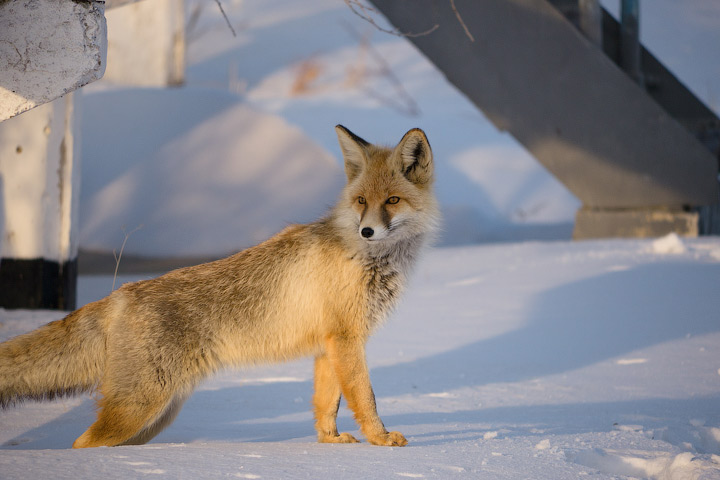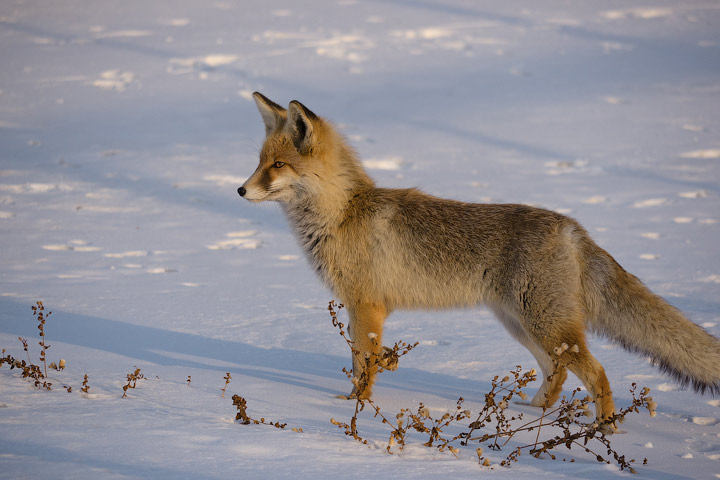Вы не зашли.
Объявление
"Давайте только проявлять больше внимания, терпимости и уважения к чужому мнению — вот и всё." — Gennadius.
— О размещении изображений на форуме, О рекламе на форуме
#151 22 December 2011 17:31:28
- Crazy Zoologist
- Гость
Re: О лисицах в целом (Vulpuni)
Allosaur, http://www.youtube.com/watch?v=gi7tN2rj … re=related
I takih video polno. Est protiv alligatora.
#152 22 December 2011 17:40:35
- зоотехник
- Модератор

- Откуда: Орловское Полесье
- Зарегистрирован: 08 February 2010
- Сообщений: 2809
Re: О лисицах в целом (Vulpuni)
Rafailov :
P.s. В общем, по рассказам многих моих знакомых, можно сделать вывод, что в этом году лисы встречаются у нас чуть ли не повсеместно, хотя зайца как не было, так и нет, зато мышей достаточно.
да в общем это и не удивительно - для лисиц зайцы, вовсе не основной корм, в отличие от мышевидных грызунов... Вот для рысей отсутствие зайцев куда катастрофичней
не давно читал наблюдения одного мужика в Канаде, он пишет что у них лисы являются основным регулятором численности парковых белок! Правда белки у них здоровенные!
http://www.naturelight.ru/show_photo/37178.html
Отредактировано зоотехник (22 December 2011 17:43:10)
ЧЕЛОВЕК - это звучит гордо! Обезьяна - перспективно!
Неактивен
#154 22 December 2011 20:22:59
- Wladimir
- Без пяти минут зоолог
- Зарегистрирован: 07 April 2008
- Сообщений: 1745
Re: О лисицах в целом (Vulpuni)
Тибетская лисица.
http://www.youtube.com/watch?v=N301BQtZezs
Неактивен
#155 22 December 2011 23:34:39
- зоотехник
- Модератор

- Откуда: Орловское Полесье
- Зарегистрирован: 08 February 2010
- Сообщений: 2809
Re: О лисицах в целом (Vulpuni)
кот и лиса. Знакомство.
http://www.youtube.com/watch?v=eMqSN4hF … re=related
ЧЕЛОВЕК - это звучит гордо! Обезьяна - перспективно!
Неактивен
#156 23 December 2011 03:31:03
- Rafailov
- Без пяти минут зоолог

- Откуда: Покровск, Якутия
- Зарегистрирован: 06 July 2010
- Сообщений: 1400
Re: О лисицах в целом (Vulpuni)
Artem :
Честно говоря и в Харьковской области очень много лисиц развелось.
Значит в уходящем году лисы рулят!
Прежде, чем бороться со мной за экологию, сначала посчитайте, сколько горючего сжигает ваша посудина!
Неактивен
#157 27 December 2011 21:17:46
- Crazy Zoologist
- Гость
Re: О лисицах в целом (Vulpuni)
Лисичка по кличке Рокси из Уорикшира (Warwickshire), Великобритания, ходит как обычная собака в ошейнике, на поводке, питается кормом для собак и играет с игрушкой в виде косточки.
Рокси была найдена в лесу: она запуталась в проволочной ограде, выбраться из которой самостоятельно не могла. После оказанной медицинской помощи и реабилитации, стало ясно, что лисичка стала совсем ручной, и возвращение в лес — означало бы для неё верную гибель.
В дом к 61-летнему Джеффу Грейкоку (Geoff Grewcock) лисичка попала из центра по спасению диких животных в Нанитоне (Nuneaton). Джефф сразу же соорудил для неё в саду будку и познакомил со своими собаками. Уже совсем скоро у Рокси стали появляться обычные собачьи повадки, а от охотничьего инстинкта не осталось и следа, рассказывает г-н Грейкок. Она отказывается есть сырое мясо и совершенно спокойно может находиться в курятнике, в то время как куры могут клевать её. Зато жареную курицу она с удовольствием съест на ужин.
Местные жители Нанитона сразу же поднимают шум, как только видят выходящую на прогулку Рокси. Для них это что-то удивительное и необычное. Лиса на поводке, гуляющая в компании собак, которая ведёт себя точно также как собака. Однажды, подойдя к коляске с ребёнком, она запрыгнула в неё и уснула там, свернувшись на одеяле калачиком. Мама малыша была не против её присутствия там.
Как сообщает Daily Mail , Рокси время от времени позволяют поиграть в доме, но она с другими собаками переворачивает весь дом кверху дном, поэтому их сразу же отправляют на задний двор. У лисички возле её будки множество игрушек и она частенько пытается дразнить ими остальных собак. Например, подсовывает через изгородь им игрушку в виде собачьей косточки, а потом быстренько её забирает обратно.
- Рокси очень нравится у нас. Она должно быть самая избалованная лисица в Великобритании, — улыбается Джефф.
(с) http://zoopark.su/lisa-s-sobachimi-povadkami/
#158 31 December 2011 04:37:11
- Crazy Zoologist
- Гость
Re: О лисицах в целом (Vulpuni)
Рыжая лисица и корсак.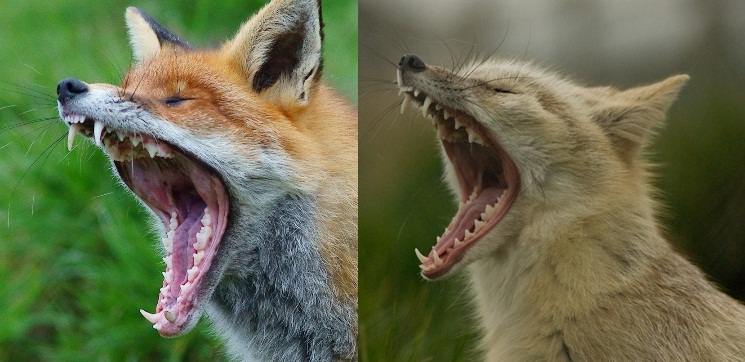
#159 14 January 2012 20:33:38
- 5123naa
- Любопытный
- Откуда: Новосибирск
- Зарегистрирован: 14 December 2010
- Сообщений: 25
Re: О лисицах в целом (Vulpuni)
На ютубе, как я посмотрел, достатчоно популярен жанр "Лисица и кот".
Просто очень красивое видео лисицы в зимнем саду
http://www.youtube.com/watch?v=yhXaOK8P … re=related
А тут позитивный и кипишной фенек, роющий диван
http://www.youtube.com/watch?v=IVDtq0A8 … re=related
Ну и напоследок просто лисица с роскошным хвостом, попытавшаяся наехать на лежавшую на дворе кошку. Интересно, что она попутно активно метила столб. Смотреть лучше без звука, у комментатора очень неприятный говор.
http://www.youtube.com/watch?v=jgjCsCur … re=related
P.S. Что-то у корсака клыки игрушечные, ни пробить, ни вырвать. Понятно, что они по мелким животным специализируются, но не настолько же...
Неактивен
#160 24 January 2012 21:35:07
- joint831
- Любопытный
- Зарегистрирован: 28 March 2010
- Сообщений: 31
Re: О лисицах в целом (Vulpuni)
Заснял сегодня лисицу в степи (Казахстан, мороз -15), чесала куда-то по своим делам.
Кстати, это корсак?
Интересно было увидеть зверя на быстром бегу.
Передняя левая лапа вроде поранена (или кровь добычи?).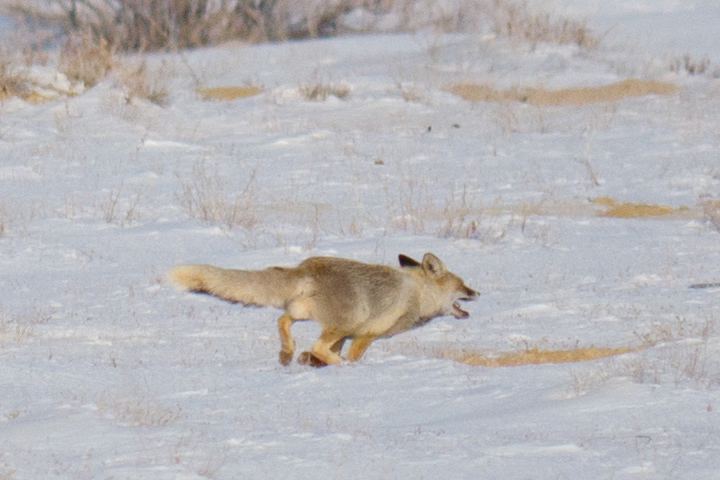
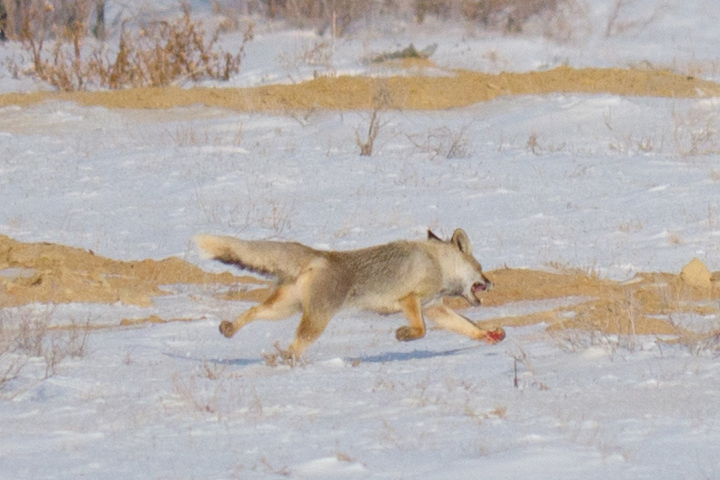
Неактивен
#161 26 January 2012 17:08:27
- Саша
- Без пяти минут зоолог

- Зарегистрирован: 06 April 2007
- Сообщений: 1539
Re: О лисицах в целом (Vulpuni)
интересно что в районе где я живу, в 5 минутах ходьбы от моего дома есть парк-променад, там много зелени и кустов недавно я там проходил вечером уже темно было, видел 2 лис. удивился потому как место ооочень людное, и дети и шашлыки жарят итд. я их там и раньше видел, сразу принял за волка или шакала но потом решил что это лиса. если повезет сделаю снимок и покажу
Coyote man
Неактивен
#162 26 January 2012 17:29:43
- зоотехник
- Модератор

- Откуда: Орловское Полесье
- Зарегистрирован: 08 February 2010
- Сообщений: 2809
Re: О лисицах в целом (Vulpuni)
joint831 :
Заснял сегодня лисицу в степи (Казахстан, мороз -15), чесала куда-то по своим делам.
Кстати, это корсак?
Интересно было увидеть зверя на быстром бегу.
Передняя левая лапа вроде поранена (или кровь добычи?).
http://fotkidepo.ru/photo/178228/21834B … 29722w.jpg
http://fotkidepo.ru/photo/178228/21834B … 29723w.jpg
Вроде это обыкновенная лисица, они в Казахстане некрупные и светлые, но корсак ещё стройнее...
ЧЕЛОВЕК - это звучит гордо! Обезьяна - перспективно!
Неактивен
#163 13 February 2012 19:35:20
- joint831
- Любопытный
- Зарегистрирован: 28 March 2010
- Сообщений: 31
Re: О лисицах в целом (Vulpuni)
Неактивен
#164 13 February 2012 20:20:41
- зоотехник
- Модератор

- Откуда: Орловское Полесье
- Зарегистрирован: 08 February 2010
- Сообщений: 2809
Re: О лисицах в целом (Vulpuni)
Жалко на нижней фотке хвост не вошёл..., а так здорово! мне на днях удалось просто для факта сфоткать и то рад! :
ЧЕЛОВЕК - это звучит гордо! Обезьяна - перспективно!
Неактивен
#165 13 February 2012 20:39:46
- joint831
- Любопытный
- Зарегистрирован: 28 March 2010
- Сообщений: 31
Re: О лисицах в целом (Vulpuni)
Есть еще две и с хвостом полностью! Только тут морда не такая выразительная.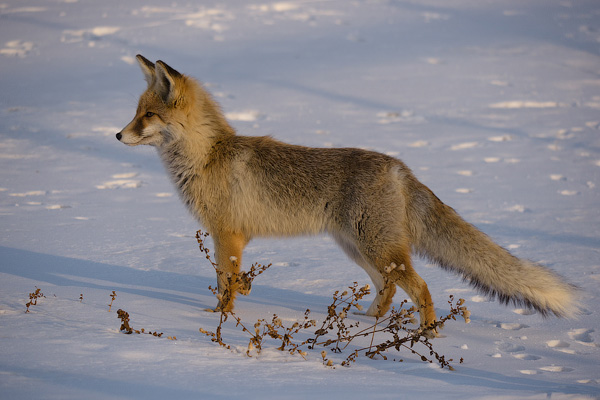
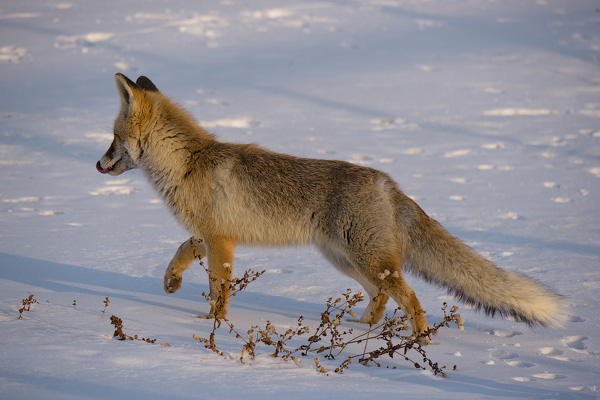
Отредактировано joint831 (13 February 2012 20:40:23)
Неактивен
#166 13 February 2012 21:28:03
- зоотехник
- Модератор

- Откуда: Орловское Полесье
- Зарегистрирован: 08 February 2010
- Сообщений: 2809
Re: О лисицах в целом (Vulpuni)
Верхняя очень даже! а чего на натурлайт не выложили?
ЧЕЛОВЕК - это звучит гордо! Обезьяна - перспективно!
Неактивен
#167 13 February 2012 21:46:24
- joint831
- Любопытный
- Зарегистрирован: 28 March 2010
- Сообщений: 31
Re: О лисицах в целом (Vulpuni)
Да надо бы...
Какую посоветуете?
Неактивен
#168 13 February 2012 21:52:12
- зоотехник
- Модератор

- Откуда: Орловское Полесье
- Зарегистрирован: 08 February 2010
- Сообщений: 2809
Re: О лисицах в целом (Vulpuni)
третью. а корсачки на глаза не попадаются?
ЧЕЛОВЕК - это звучит гордо! Обезьяна - перспективно!
Неактивен
#169 14 February 2012 10:18:09
- Rafailov
- Без пяти минут зоолог

- Откуда: Покровск, Якутия
- Зарегистрирован: 06 July 2010
- Сообщений: 1400
Re: О лисицах в целом (Vulpuni)
joint831 :
Вот такую красавицу еще удалось сегодня поймать:
По клику ссылки на полноразмеры.
http://fotkidepo.ru/photo/178228/21834B … 36028w.jpg
http://fotkidepo.ru/photo/178228/21834B … 36029w.jpg
зоотехник :
Жалко на нижней фотке хвост не вошёл..., а так здорово! мне на днях удалось просто для факта сфоткать и то рад! :
http://s018.radikal.ru/i521/1202/62/74e4501b57dc.jpg
Такое чувство, что у вас лисы на каждом шагу встречаются.
Прежде, чем бороться со мной за экологию, сначала посчитайте, сколько горючего сжигает ваша посудина!
Неактивен
#170 20 February 2012 15:42:44
- Vulpes v. fulvus
- Заглянувший

- Зарегистрирован: 16 February 2012
- Сообщений: 2
Re: О лисицах в целом (Vulpuni)
Один интересный эксперимент по селекции лисиц:
http://nnm.ru/blogs/lapuchka_/a_esli_vy … ete/page2/
Неактивен
#171 10 May 2012 22:22:15
- Crazy Zoologist
- Гость
Re: О лисицах в целом (Vulpuni)
Черепа рыжей лисицы и черного грифа.





#172 11 May 2012 19:04:43
- Crazy Zoologist
- Гость
Re: О лисицах в целом (Vulpuni)
Карликовую лисицу также называют американской. При этом американской лисицей также называют американского корсака. А это разные виды. В общем на русском путаница.
Американская карликовая лисица (Vulpes macrotis).
Серая лисица.
Серая (А) и карликовая (В) лисицы.
#173 13 May 2012 20:43:29
- Crazy Zoologist
- Гость
Re: О лисицах в целом (Vulpuni)
ОГРОМНЫЕ РЫЖИЕ ЛИСИЦЫ: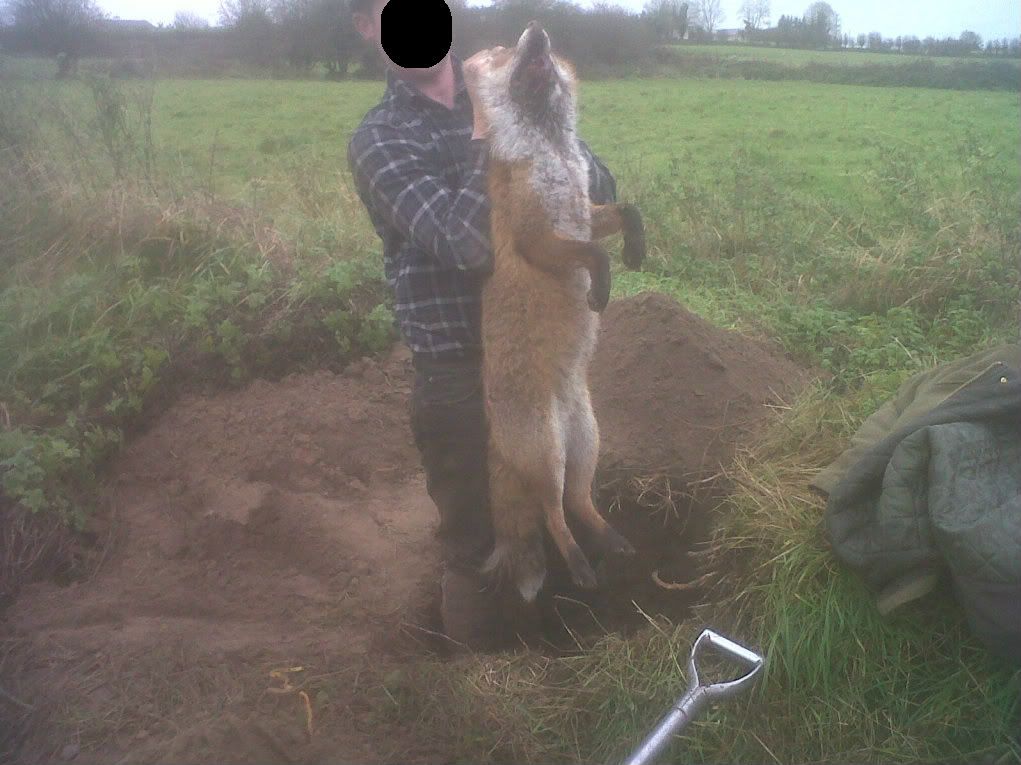
Coyote-sized fox killed in England
January 20, 2012 by retrieverman
A 35.5 pound fox! That’s the size of a typical coyote bitch in my part of the world.
Why are the foxes getting larger?
I would submit that they are simply evolving to fit a niche that has been left vacant when wolves were extirpated from the British Isles. Something very similar happened when wolves were killed off in the Eastern US, and Western coyotes wandered in. They grew larger in size to be more effective predators of deer.
I also think that fox hunting ban in Britain has had an effect. The fox hunts always exerted upon foxes a relatively strong selection pressure to remain small. If a fox is small enough, it can fit into the narrowest places and avoid the hounds. With the hunting ban, there is no longer much of a selection pressure to remain small. A larger fox that exists hounds hunting it has certain advantages in obtaining access vixens and good hunting territory, and its prey choices become wider. A fox of that size might be a threat to some of the smaller deer species– and it certainly would be able to take relatively large lambs.
http://retrieverman.wordpress.com/2012/ … n-england/
Giant red fox killed in Kent
January 4, 2011 by retrieverman
From The Telegraph:
The male fox weighed two stone or 26.5lb and was four foot long, about the height of a seven-year-old child.
The giant fox was captured and killed in Maidstone after a cat in the local neighbourhood was killed.
It was trapped in a cage and put down in a humane way by Keith Talbot, a local vet.
He said foxes had been seen around his parents house days after their 19-year-old tabby cat was found killed on the doorstep.
Zoologists and experts said foxes said foxes could be growing bigger because of ‘easy pickings’ of food scraps in dust bins or even left out by animal lovers.
A dog fox will often grow bigger than the rest of the pack because the social system means the alpha male gets most of the food and the rest get leftovers.
There are thought to be at least 34,000 urban foxes in Britain.
Recently there has been concerns the animals could pose a threat after twins Isabella and Lola Kouparis were attacked in their beds in London.
However animal rights campaigners point out that most foxes live on insects and small mammals and pose no harm to humans unless they are frightened.
The Field Sports Channel is offering £100 for the best story of the largest fox. One taker has come forward with claims he shot a fox weighting 34lb in 2009, although this has not been confirmed with photographic evidence.
I guess the English have adopted one of our customs. In the US, there are coyote killing competitions. In the West, these competitions are about seeing who can kill the most coyotes within a given amount of time. In the East, where big coyotes are legendary, the goal is to see who can kill the biggest one. Anyone who kills a black, white, or otherwise unusually colored individual also gets plaudits. (Remember, the ones in the East have some wolf ancestry.)
Another reason why these foxes could be getting larger is that they have virtually no predation. Wolves no longer exist in England, and fox hunting has been banned. That means that foxes now exist at higher densities than they once did, and it may be that foxes that are bigger and tougher are better at competing for both vixens and food resources than smaller ones. With all of these foxes living in relative proximity to each other, it may be that a dog fox that has some size advantage might be better able to spread his genes, simply by muscling his way around smaller individuals.
And access to food would also play a role. These foxes now have the nutrition to reach larger sizes.
The fact that this fox was killed in town means that he likely had access to really good nutrition his entire life. His ancestors may have been working their way towards the larger size as I describe may become possible when foxes exist at high densities.
Red foxes do vary quite a bit in size. A 26 to 34 pound fox is much larger than any fox around here. It actually would put them in the same class as the smallest of coyote bitches.
Now, I’ve never seen one in North America of this size, but I did see one last week.
It was a taxidermied specimen at the German Hunting and Fishing Museum (Deutsches Jagd- und Fischereimuseum). I was shocked at how large this fox was. It was the size of a beagle.
Where I live, red and gray foxes are about the same size– 8-12 pounds. Virtually all red foxes here are derived from English imports to Maryland and Virginia in the seventeenth and eighteenth centuries. Genetically and morphologically, they are almost exactly the same as those foxes in England. Of course, there was a small native population of red foxes that lived in what is now the eastern US, but they were not that common before European settlement. (However, they did exist in Virginia during the Pleistocene).
The ones here also have very distinct black legs, which this particular fox does not have. Only its feet are black.
With 45 different subspecies of red fox, we should see lots of variance between them. Not only do they come in several distinct phases in the wild, they also vary quite a bit in terms of size.
As wild dogs go, they are the true inheritors of the wolf’s empire. They are now more widely distributed than any other wild carnivore. Not only do they still maintain a vast Holarctic range, that also includes the Nile Valley, they are also found in Australia. Like wolves, they have the ability to rapidly respond to selective pressures and change their morphology and behavior to fit new ecosystems and new niches.
Large size may be of some advantage for certain populations, and that is probably the main reason why giant foxes are starting to appear in different European countries.
But if that readily available food supply disappears and the foxes find themselves suffering from both competition and predation from other animals, the large size may not be quite so advantageous.
http://retrieverman.wordpress.com/2011/ … d-in-kent/
'Largest fox killed in UK' shot on Aberdeenshire farm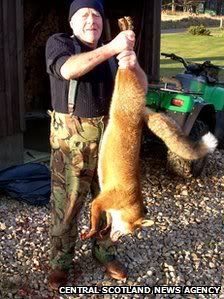
Alan Hepworth said he took no pleasure from shooting the fox
A fox believed to be the biggest killed in Britain was shot after attacking lambs on an Aberdeenshire farm.
It weighed 38lbs 1oz (17.2kg) and was 4ft 9in (1.4m) from nose to the tip of its tail. On average the animals tend to weigh up to about 15lbs (6.8kg).
Alan Hepworth, 69, from Rothiemay, shot the fox on a friend's farm and said its size was "incredible".
He said: "We take no real pleasure from it. It's just what we have to do to stop them getting out of control."
Mr Hepworth explained: "We have to shoot foxes to keep on top of them, and stop them from killing the lambs.
"It was late at night, and this particular fox caught our eye because it was such an incredible size.
"When we went over to pick it up, we were amazed by quite how big it was.
"I could only hold it for a while because it was so heavy and was nearly as big as a roe deer."
He added: "I'm 5ft 7in, and it was 4ft 9in. When I held it up, it was almost the same size as me."
Jonathan Reynolds, senior research scientist at the Game and Wildlife Conservation Trust (GWCT), said: "A 38lbs fox would have been unthinkable a few years ago.
"We don't know why they are getting bigger, but one possible explanation is that they are getting better fed in urban areas."
http://www.bbc.co.uk/news/uk-scotland-n … d-17259087
BBC news did a suprisingly good article of this, which I also put in the Red Fox profile.
"A fox believed to be the biggest killed in Britain has been shot after attacking lambs on an Aberdeenshire farm. The fox led some commentators to suggest that food left by people is leading to more outsized red foxes.
But are red foxes getting larger, and if so, why, asks the BBC within its Question of Nature series?
The huge fox recorded in Scotland weighed an impressive 38lbs 1oz (17.2kg), sparking speculation about what caused the animal to become so big.
Generally, the availability of food does have an impact on the body size of red foxes - but the relationship is not as clear cut as might be expected.
Red foxes (Vulpes vulpes) are one of the most ubiquitous of all mammals, occurring throughout most of Europe, including the UK, and Asia and in parts of Africa and the Middle East.
This wild dog, or canid species has been introduced to Australia where it is now widespread, and in North America it is present throughout much of Canada and the United States.
Red foxes have also colonised a range of habitats including semi-arid deserts, tundra, farmland, boreal forests and metropolitan areas.
Their adaptability is reflected in their diet; red foxes are omnivorous and feed on a variety of animals and plants, including insects, small mammals such as rodents and rabbits, birds, earthworms, eggs, berries, fruits and seeds. In some parts of their range they will take turtles, frogs, snakes, fish and even deer fawns and ringed seal pups.
In 1995, Paolo Cavallini of the University of Siena in Italy published a study called "Variation in the body size of the red fox", which has been regularly cited by scientists since. In that study, he examined the body size of red foxes worldwide.
Males tended to be 5-6% larger and more massive than females, but the size of both sexes varies considerably depending where in the world they lived, it found.
For example, that research found that male red foxes in Scotland averaged 16lbs (7.3kg), and Wales 14lbs (6.4kg), whereas those in England averaged somewhere between these two weights; 14lbs (6.4kg) and 16lbs 4oz (7.4kg) depending on the study area.
Foxes in the state of Maryland, US however, were much smaller, averaging just 9lbs 6oz (4.3kg).
A more recent study published in 2008 by Carl Soulsbury and colleagues at the University of Bristol, UK, examined foxes living in the city up until 2004.
It found the average weight of the male fox to be closer to 13lbs 3 oz (6kg).
"We're not seeing urban foxes getting any bigger," says Professor Stephen Harris, a co-author of the report.
"I've been researching urban foxes for about 40 years and the biggest fox I've had has been about 23lbs in an urban area," he says.
"But we've had foxes under 10lbs and maybe 9lbs. You have quite a range of sizes."
He says the large fox caught in Aberdeenshire is simply a rare, but normal specimen. Media reports that the previous largest UK fox on record weighed 26lbs are not true, he says.
Similar-sized foxes have been recorded centuries ago, he says. "This fox was about 38lb and in the 18th Century hunting literature we've got foxes up to 36lb.
"This fox is unusual but it's an outlier. Once every so often we get a very big fox but I wouldn't expect anything else."
Eating waste
But in other countries, there is some evidence that red foxes are generally getting bigger.
In Israel, a study published this year by Yoram and Shlomith Yom-Tov from Tel Aviv University found that red foxes there have grown larger, with the trend starting in the 1930s and stabilising in the 1980s. During this period human populations grew 16-fold in the country, the standard of living increased 10-fold and the area of worked land increased by 50%.
Today garbage in Israel includes at least 40% organic waste, say the authors, providing a steady source of available food to birds and mammals, including foxes.
The researchers have found a similar trend among foxes living in Denmark, while studies in Spain have shown that red foxes living in good habitats are on average 14-19% heavier than those living nearby in poorer habitats.
However, no such trend has yet been found in the UK, though researchers have found that back gardens are the most important foraging habitat for urban foxes.
Outside of urban areas, other foxes are showing changes in body size.
Another study in Spain, also by Yoram and Shlomith Yom-Tov, collated measurements of red fox skulls over the 20th Century. It found that red foxes living in agricultural areas were significantly larger than those living elsewhere.
These larger foxes are living off food scraps, but leftovers used to feed livestock, rather than from people. They may also scavenge or kill the livestock itself.
But other, perhaps unexpected factors influence fox size as much as human leftovers and agriculture.
Dr Soulsbury's and Prof Harris's 2008 study also examined how diet and environmental conditions affect the body size of red foxes in the UK.
Surprisingly perhaps, variation in rainfall and the abundance of earthworms most influenced how large a fox will be when it grows up.
Generally, red foxes attain full grown mass during their first year of life, and the researchers found that Bristol foxes achieved their adult weight around October in the year they were born.
They then eliminated from their data any foxes suffering from sarcoptic mange, a potentially fatal disease that causes a loss of muscle and mass. They also accounted for any changes in population density that might affect body size.
After studying the Bristol foxes for a number of years, they found that larger cubs do, as perhaps might be expected, become larger adults.
But that effect is more than swamped by the effect of rainfall, according to the study published in the Proceedings of the Royal Society B journal.
Cubs growing up in areas that experience heavy rainfall in July tend to grow significantly larger than those that don't.
"The difference between a dry summer and a wet summer is about 18% in body size," says Prof Harris.
That is because heavy rainfall causes more earthworms to come to the surface. And earthworms are about the only prey that young foxes, unskilled at hunting, are able to catch and eat in the few weeks after they stop suckling from their mothers.
Conversely litter size and the size of the mother fox does not predict how big cubs will grow.
Is being bigger actually better for foxes?
A 2008 study in the Journal of Mammalogy, again by Carl Soulsbury and colleagues, found that heavier males hold larger territories and defend them better against their rivals.
This study, the first to show the affect of body mass in generally monogamous mammals, also revealed that heavier male foxes move over wider areas, and further from their territories. In doing so, they mate more with other females (known as extra-pair matings) and sire more offspring as a result.
So males at least do benefit from growing larger. Bigger females conversely do not appear to produce bigger litters.
Freaky or frequent?
But what will the future bring?
Despite these trends towards bigger sized foxes living in certain habitats, particularly those closer to human settlements and agriculture, foxes are not necessarily destined to become bigger.
Even the reported trends towards larger size are likely to be local, and transitory.
A 2009 study published in Global Ecology and Biogeography showed that French red foxes are decreasing in size, while those in adjacent Benelux or in Alaska are not altering size at all.
That research examined the sizes of skulls held in museums of more than 4400 specimens from 22 carnivore species from 52 populations sampled around the world in the past few decades.
Overall it found that the majority of carnivores, including wolves, badgers and weasels among others, are not changing in size.
There is even less evidence that any size changes are truly adaptive; that the genes of carnivores such as foxes are evolving to produce bigger foxes.
More likely is that occasional changes happen on an individual level.
Where large foxes are found, they are not evolving to become bigger, but rather they have simply had the chance to eat more as they are growing, either earthworms or food left out by people, filling out their genetic potential.
Big foxes, it seems, happen to be normal foxes that have eaten a lot, not freaks or the product of a new evolutionary trend. And they have likely occurred throughout history."
http://www.bbc.co.uk/nature/17270249
#174 14 May 2012 00:07:39
- Miracinonyx
- Любитель животных

- Зарегистрирован: 05 December 2006
- Сообщений: 19226
Re: О лисицах в целом (Vulpuni)
Очень интересные статьи, Атрокс, спасибо.
В целом, у бибиси взвешенная позиция, но я бы не отбрасывал высказывалия человека, который подчеркнул, что лисица по сути осталась верховным хищником в большинстве районов европы. Она избавлена от давления своего основного врага - волка, потому что люди его истребили. И в британии она теперь избавлена и от давления свор охотничьих псов, которым раньше бритты травили лис. То же самое происходит в Австралии, где популяции людей и собак (охотничьих и одичавших, включая динго) во многих районах не велики, а аборигенный сумчатый хищник, тилацин, уничтожен 5 тыс. лет назад. - Как и в британии, лиса там де-факто стала верховным хищным зверем. В таких условиях действительно может начаться сдвиг в нишу более крупного хищника, чем было ранее, когда лисицу давили конкуренты. КРупные размеры при наличии добычи всегда выгодны, и сбрасывать со счету возможность эволюции лисиц в этом направлении я бы лично не стал. Вряд ли абсолютно все объясняется просто хорошим питанием лисят в детстве.
Неактивен
#175 14 May 2012 01:15:36
- Crazy Zoologist
- Гость
Re: О лисицах в целом (Vulpuni)
Да, тут ты прав. Наверное потому и лисы там так вымахали.
